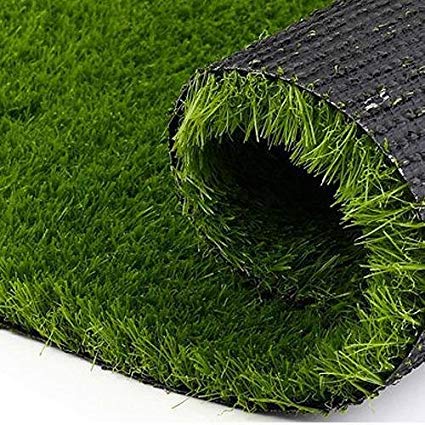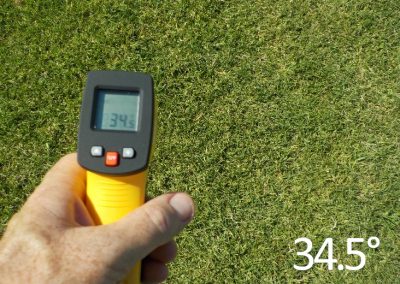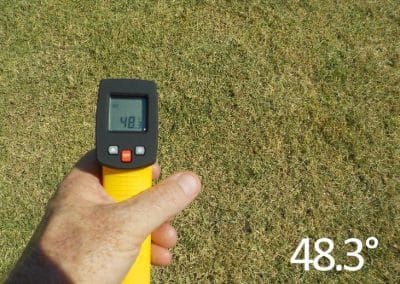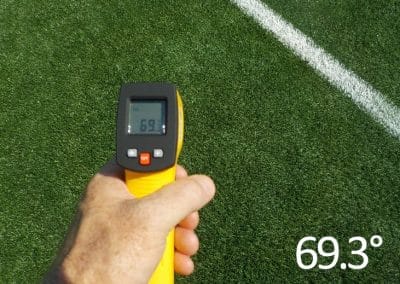Turning up the Heat on Artificial Grass
Turning up the Heat on Artificial Grass
Why do people choose artificial grass rather than a turfed lawn? Convenience, mostly.
If anyone gives you a different reason, they’re either lying or ill-informed. All too often artificial grass is said to save water, be better for hay fever or less maintenance. While all these claims have elements of truth in them, they don’t give you the whole picture.
Artificial grass may not need to be watered when it hasn’t rained, but it will need to be watered every time you want to use it in summer. You may not need to get the mower out, but you will still need to regularly clean the artificial grass.
Before you choose artificial grass for your home, it’s important to consider the consequences. The biggest one being the heat of artificial grass in our Australian summer.
Just what is the difference in heat on artificial surfaces?
It’s safe to say that we all know how hot Australia can get, especially in summer. That’s why, it’s important to do what we can to reduce the heat, rather than add to it. And a healthy lawn is your best surface option to do just that.
On a sunny summer day, a healthy lawn will be up to:
- 10°C cooler than bare soil,
- 20°C cooler than asphalt, concrete or pebble much and,
- 40°C cooler than dry artificial turf.
As well as the severe difference in temperature, natural turf is also far less likely to cause extreme heat stress compared to artificial surfaces.
But you don’t need to just take my word on it. The proof is right here:
Why is there such a difference?
The reason why there is such a dramatic difference comes down to a couple of factors. The first is the material used in each type of artificial surface and the second is that material’s ability (or inability) to retain water.
Artificial grass is typically made of materials plastics and recycled rubber. The ‘grass blades’ will consist of a mixture of polyethylene, polyester, polypropylene and nylon, whereas the base is usually made of sand and crumb rubber (typically from recycled tires). Holding all of this together is a mixture of padding materials coated in chemicals such as polyurethane or latex. It’s essentially a plastic rug!
All of these materials, especially rubber, easily absorb light and convert it into heat. This process of heat transfer only contributes to urban heating. However, that’s not the whole story.

The other factor is the material’s ability to retain moisture. Natural grass holds moisture in the soil and in its blades. This makes it not only cooler to the touch but also cools down the surrounding environment. Natural turfgrass and other plants achieve this through a process evaporative cooling, similar to how we sweat. Through this process, plants release moisture into the air, cooling it and in turn the air cools you.
Pavement and artificial turf don’t retain water at all which means they only further contribute to urban heating rather than reducing its effects as natural grass does.
Water requirements
One of the main reasons people choose artificial turf is because they are led to believe it requires less water and maintenance than grass. What isn’t factored into this equation is that in the summer heat, you need to water your artificial grass every time you want to use it, otherwise it will be too hot to touch. People also don’t consider the need to clean artificial grass or what happens after its 5-10 year lifespan.
During summer artificial grass can reach temperatures that makes walking on it unbearable, not to mention just being in the same area as the grass rug. The only thing you can do is water the grass down, using water as a temporary solution. Although natural grass does need watering more often, it naturally cools the surrounding air as well as maintaining soil health, positively effecting the surrounding environment.
Residents of the City of South Perth now require permission to install synthetic turf on their verges.
“There are a number of reasons why the city doesn’t endorse artificial turf on verges,” said Mayor James Best. “These include environmental impacts such as a reduction in soil health, biodiversity, increased radiant temperature and increased run-off sue to impermeability, resulting in pressure on drainage systems.”
This leads to another issue, drainage. If you don’t set up a thorough drainage system before installing your artificial grass, the rain can wreak havoc on your yard. Without proper drainage, the only choice water has is to puddle on the surface. What’s more, barely any water will reach the soil underneath the synthetic grass which will drastically decrease the health of your soil and make it harder to grow natural grass or other plants there in the future.
Care requirements
You will also need to regularly maintain and clean the artificial grass. If you have pets, their hair will collect in the plastic rug, as will any faeces. Even if you don’t have pets, bird droppings will still need cleaning as well as sweat, saliva or blood from us. Dust will also build up, making the artificial grass a nightmare for people suffering from hay fever.
To maintain your artificial grass, you’ll need to regular rake it to remove hairs and to straighten the fibres. You’ll also need to wash the plastic down with water to get rid of dust and sweat. Tougher stains such as blood, faeces, vomit or food may require bleach or strong chemicals to clean them away. These toxic chemicals will eventually drain into the water system, negatively effecting the environment.
In the end, artificial grass is only going to last about 5 years, up to 10 if you care for it properly. Due to the materials it’s made of, it will go directly to landfill. Then, you will need to replace it. The production of artificial grass has a significant carbon footprint and you will be forking out another $75 – $100 per square metre.

Caring for a healthy lawn
On the other hand, caring for a healthy lawn can be therapeutic and will have great benefits for the environment. As well as cooling it’s surroundings, your natural grass will keep your soil healthy and provide a safe environment for animals, insects, bees and birds.
If you’re worried about using too much water, you can set up a rain sensor with your sprinkler system. This will make sure your lawn is only watered what it needs and when it rains, you won’t be wasting any water.
The time you spend maintaining your natural grass lawn is time well spent when you think about the pleasant environment you create for relaxing in the sun, having friends over for BBQs and watching your children safely play sports.


read more!
recent posts
How To Tell – Dormant Grass vs Dead Grass
Many people consider brown grass to be dead but this is not always the case. Instead, brown grass could simply mean it’s dormant.
Before finding a solution to the problem, you first need to identify what’s causing your natural grass to change in colour.
Lawn Care After Heavy Rain
Your lawn also loves rain but it can’t survive more than 4 days submerged underwater. When the rain starts pouring, you should know what to do and how to take care of your turf. Heavy rain can flood your lawn, it can cause soil erosion, bring in unwanted debris, and can disrupt healthy roots.
Can Grass Grow in Sandy Soil
Soils with high sand content tend to drain quickly, meaning your grass will require more watering, but lawns are also less prone to problems with standing water, such as turf diseases, which can damage or kill turf grass.
Is Sir Walter Buffalo Grass Safe for Dogs?
Quick LinksBenefits of Sir Walter Buffalo Grass for pets Keeping dogs safe with a Sir Walter lawn Keeping Pets Safe in Your Yard Why you should avoid artificial grass How to Maintain a Healthy Lawn With Pets Natural lawn solutions Using dog rocks to prevent urine...








